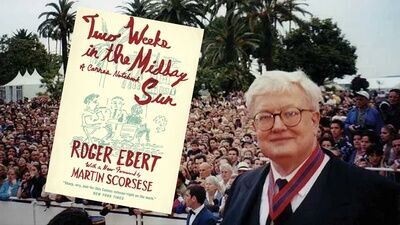Thankfully, nothing like that has happened for a while. Waiting in line is still a part of the Cannes experience today, but a bit less so. In recent years, the festival has implemented advance electronic reservations and ticketing for most screenings. With ticket holders knowing they’ll have a seat waiting for them, it’s greatly reduced the length and tension level in today’s queues.
One area where the queue maintains its importance is the lines for the official press conferences. No advance tickets are distributed for journalists other than for the camera technicians at extremely popular conferences. Seats at the press conferences are first-come first-served based on your badge color. Truthfully, only a small percentage of journalists attend the press conferences themselves. An even smaller percentage actually ask questions of the filmmakers during the conferences. But Roger was a fixture at these events, even if he was sometimes embarrassed by the silly questions posed by his colleagues. Today, the occasional silly questions remain, but although Roger is no longer in attendance, Chaz has become a central figure. Although she often conducts one-on-one interviews with many notable figures in Cannes, she maintains a regular presence at press conferences as well, generally sitting front and center. Filmmakers like Quentin Tarantino, Spike Lee, and Martin Scorsese insist to the moderators that she’s chosen to ask a question. And she even makes national news on occasion as she did in 2016 with George Clooney when she asked him about the upcoming presidential election. I think Roger would be very happy to see Chaz hold court each year at the press conferences in Cannes.
One film in the 1987 competition that the book covers extensively is Barbet Schroeder’s “Barfly,” starring Faye Dunaway and Mickey Rourke. Roger had some unique access to the making of that film, and so he had a lot to write about the subsequent premiere in Cannes. I would have loved to have been a fly on the wall to hear the discussion between Roger and Charles Bukowski, who wrote the script for the film.
Although it occurred in 1979 rather than 1987, Roger recalls the invitation and subsequent events around one of the most famous press conferences and Cannes screenings ever for “Apocalypse Now.” Coppola arrived with an unfinished film, wasn’t sure which ending to show, and flanked himself with his children, seemingly for protection from the press. This year, Coppola returns to the competition in Cannes for the first time since 1979 with his passion project, “Megalopolis.” Will Roman and Sofia be at his side again this year? We’ll have to wait and see.
Just as Coppola returns to Cannes this year, so will Faye Dunaway. A documentary about her life and career by director Laurent Bouzereau will play in the Cannes Classics section in 2024.
Barfly was produced by Menahem Golan’s Cannon Films, and if there is a central character of Two Weeks in the Midday Sun outside of Roger himself, it’s Golan. He’s a larger-than-life figure who parlayed the financial success of his B-movies into A-list projects that competed for the Palme d’Or. And compete he did, throwing more advertising and promotion money into his films at Cannes than probably every other studio combined.

